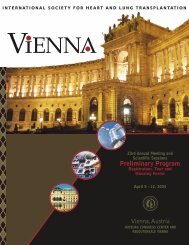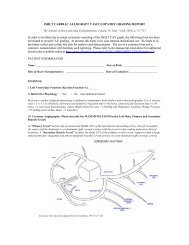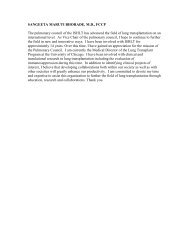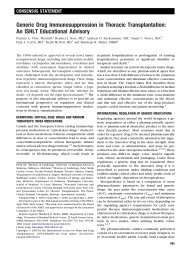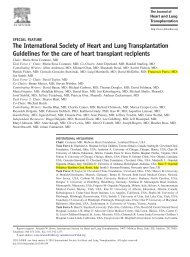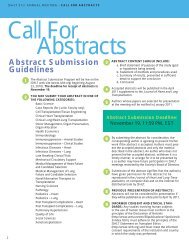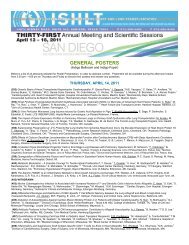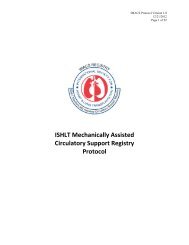IMACS Users' Guide – Version 1.0 - The International Society for ...
IMACS Users' Guide – Version 1.0 - The International Society for ...
IMACS Users' Guide – Version 1.0 - The International Society for ...
You also want an ePaper? Increase the reach of your titles
YUMPU automatically turns print PDFs into web optimized ePapers that Google loves.
<strong>IMACS</strong> Users’ <strong>Guide</strong> <strong>–</strong> <strong>Version</strong> <strong>1.0</strong><br />
12/21/2012<br />
Page 22 of 56<br />
Pre-Implant Form<br />
If patient is at home most of the time on outpatient inotropic infusion, this patient can<br />
have a modifier FF if he or she frequently returns to the hospital.<br />
INTERMACS 4: Resting symptoms describes a patient who is at home on oral therapy<br />
but frequently has symptoms of congestion at rest or with ADL. He or she may have<br />
orthopnea, shortness of breath during ADL such as dressing or bathing, gastrointestinal<br />
symptoms (abdominal discom<strong>for</strong>t, nausea, poor appetite), disabling ascites or severe<br />
lower extremity edema. This patient should be carefully considered <strong>for</strong> more intensive<br />
management and surveillance programs, by which some may be recognized to have<br />
poor compliance that would compromise outcomes with any therapy. This patient can<br />
have modifiers A and/or FF.<br />
INTERMACS 5: Exertion Intolerant describes a patient who is com<strong>for</strong>table at rest but<br />
unable to engage in any activity, living predominantly within the house or housebound.<br />
This patient has no congestive symptoms, but may have chronically elevated volume<br />
status, frequently with renal dysfunction, and may be characterized as exercise<br />
intolerant. This patient can have modifiers A and/or FF.<br />
INTERMACS 6: Exertion Limited also describes a patient who is com<strong>for</strong>table at rest<br />
without evidence of fluid overload, but who is able to do some mild activity. Activities of<br />
daily living are com<strong>for</strong>table and minor activities outside the home such as visiting friends<br />
or going to a restaurant can be per<strong>for</strong>med, but fatigue results within a few minutes of any<br />
meaningful physical exertion. This patient has occasional episodes of worsening<br />
symptoms and is likely to have had a hospitalization <strong>for</strong> heart failure within the past year.<br />
This patient can have modifiers A and/or FF.<br />
INTERMACS 7: Advanced NYHA Class 3 describes a patient who is clinically stable<br />
with a reasonable level of com<strong>for</strong>table activity, despite history of previous<br />
decompensation that is not recent. This patient is usually able to walk more than a<br />
block. Any decompensation requiring intravenous diuretics or hospitalization within the<br />
previous month should make this person a Patient Profile 6 or lower. This patient may<br />
have a modifier A only.<br />
MODIFIERS of the INTERMACS ® Patient Profiles:<br />
A - Arrhythmia. This modifier can modify any profile. Recurrent ventricular<br />
tachyarrhythmias that have recently contributed substantially to the overall clinical<br />
course. This includes frequent shocks from ICD or requirement <strong>for</strong> external defibrillator,<br />
usually more than twice weekly.<br />
TCS <strong>–</strong>Temporary Circulatory Support. This modifier can modify only patients who are<br />
confined to the hospital, Patient Profiles 1, 2, and 3 (a patient who is listed as Patient<br />
Profile 3 stable on inotropes who has been at home until elective admission <strong>for</strong><br />
implantable VAD cannot have a TCS modifier.)<br />
Support includes IABP, ECMO, TandemHeart, Levitronix, BVS 5000 or AB5000, Impella.




